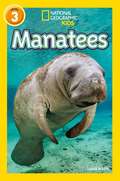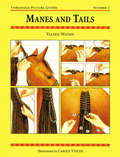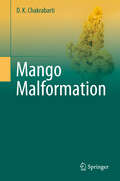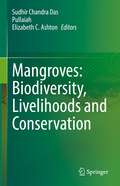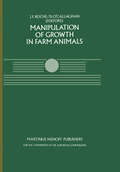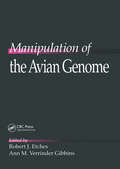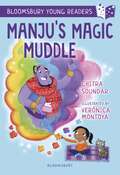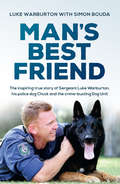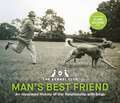- Table View
- List View
Manatees: Level 3 (National Geographic Readers Ser.)
by Laura Marsh National Geographic Kids StaffNational Geographic Primary Readers pair magnificent National Geographic photographs with engaging text by skilled authors to help your child learn to read. Developed by education experts, this series of books for beginner readers is spread across four levels: Early Reader, Becoming Fluent, Becoming Independent and Independent Reader. Young readers will explore the underwater world of lovable manatees in this engaging and fact-filled National Geographic Kids Level 3 Reader. Follow these gentle giants – sometimes called ‘sea cows’ – through their marshy habitats. Learn how manatees raise their young and discover the threats of their environment. Beautiful photos and carefully levelled text make this book perfect for independent reading with some guidance from adults. Level 3: Becoming Independent books are best suited for kids who are ready for complex sentences and more challenging vocabulary, but still draw on occasional support. They are ideal for readers of Purple and Gold book bands for guided reading.
The Mandarin Duck (Poyser Monographs #132)
by Christopher LeverThe Mandarin Duck is a small and (in the case of the males) spectacularly colourful species of waterfowl. Widely kept in aviaries around the world, populations often escaped to form wild colonies. One of the largest and best-studied is in southern England. Although declining and nowadays surprisingly hard to find, Britain's wild Mandarin population is probably more numerous than that of the duck's true home, China and the Russian Far East, where it is now endangered.This Poyser monograph is a detailed account of this beautiful duck's lifestyle and biology, with particular emphasis on invasive populations in Britain and overseas. It is a superb addition to the long-running and acclaimed Poyser series.
Man–Elephant Conflict: A Case Study from Forests in West Bengal, India (SpringerBriefs in Environmental Science)
by Nilanjana Das ChatterjeeThis book sheds new light on the causes and consequences of elephant migration in the Panchet Forest Division of Bankura District in West Bengal, India- an area characterized by fragmented forested landscape modified by agriculture and settlement expansion. Anthropogenic activities result in the decline in quality and coverage of forests, loss of biodiversity and removal of forest corridors which ultimately restrict or modify the movement of elephants causing a forceful change of their habitats. A major objective of this monograph is to identify the characteristics of man–elephant conflicts in terms of land use change, cropping patterns, ecological characteristics of the fragmented dry deciduous forest, trends and patterns of elephant migration, and livelihood patterns of the inhabitants in the affected areas. Readers will discover insights into changes in the behavioral pattern of elephants and local people in the conflict ridden zones, and how this influences food selection. Through this book we also learn about rational management strategies that can be employed on the local and national level to mitigate human-elephant conflicts.Ecologists, landscape conservation planners and environmental managers engaged in the conservation of large vertebrates in fragmenting and human-dominated landscapes will find this book valuable.
MANES AND TAILS (Threshold Picture Guides #1)
by VALERIE WATSONA step-by-step guide to the art of trimming and plaiting manes and tails.
Mango Malformation
by D. K. ChakrabartiMalformation disease of mango (Mangifera indica) initially noted in patches in India has now turned into a global menace wherever mango is grown. The challenge posed by the problem attracted interest of Scientists from various disciplines, continue to do so, and will attract their attention until the problem is understood threadbare, and resolved. For a long time, due to complex nature of the disease, the cause and causal agent was both hotly debated. Only in recent years, the issue of the etiology of the disease has been resolved, epidemiology has been worked out to a large extent and silver bullet control measures have been replaced by IPM strategy based on the information generated on the physiology of pathogenesis and epidemiology of the disease.
Mangroves: Biodiversity, Livelihoods and Conservation
by Sudhir Chandra Das Pullaiah Thammineni Elizabeth C. AshtonThis contributory volume is a comprehensive collection on the mangrove forest eco-system and its ecology, the resources and potentials of mangroves, conservation efforts, mangrove eco-system services and threats to conservation. The book is an all-inclusive compilation on the status, conservation and future of mangroves. Mangroves are a unique ecosystem providing several ecosystem services. They are formed in the inter-tidal areas of large rivers and coastal islands. Mangroves thrives due to constant interaction with the terrestrial and marine ecosystem. These are the species dynamics, varying tidal amplitudes, plant succession, changing floral pattern of the channels of the estuary, the varying sediment transportation. There was 20% decline in mangrove forest area in the last 25 years due mainly to conversion and coastal development. Lengthy recovery periods required for the degraded mangrove forests. Hence there is an urgent need to take stock of the updated information on these mangroves at global level. It is of immense value to scientific community involved in teaching, research and extension activities related to mangrove conservation.
Manipulation of Growth in Farm Animals: A Seminar in the CEC Programme of Coordination of Research on Beef Production, held in Brussels December 13–14, 1982 (Current Topics in Veterinary Medicine #26)
by J. F. RocheIn some countries, especially on the European continent, there still exists a remarkable veal market. This type of meat production seems, irrespective of any economic forecasts, to remain unchallenged so long as consumers expect that restaurants should offer courses like "r6ti de veaux", "vitello a la casa" or "Kalbsschnitzel". Producers, at least since about the past 1-/2 decades, have been aware of the beneficial effect of anabolic agents in veal production. This is possible due to the lack of endogenous sexual hormones during the juvenile or prepuberal status of these animals. A discussion about the benefit / risk - evaluation in connection with the use of anabolic agents in general was promoted in recent years by the public. This concern occurred concomitantly with the detection of illegally treated veal calves and the occurrence of diethylstilbestrol (DES) residues in canned food containing veal. The aim of this paper is to summarize the present status of residue data in edible tissues and excreta in order to allow the evaluation of the risk (given in the paper of Hoffmann within this program) and to consider reasonable monitoring measures. We have to face the fact that without an efficient control system the illegal treatment of calves can not be excluded. Therefore, this paper will not only consider different compounds and formulations, but will also deal with practised routes of administration.
Manipulation of Mammalian Development (Developmental Biology #4)
by Ralph B. L. GwatkinDevelopmental biology has been transformed recently by discoveries in the fields of molecular biology, cell biology, and immunology. New ways of manip ulating mammalian development are uncovering control mechanisms and ena bling us to apply them in solving practical problems in animal production and human health. This book outlines some of these new manipulations and how they have contributed to the present state of developmental biology. Chapter 1 describes gene transfer by micro injection of cloned recombinant DNA into zygotes. Although the factors that affect transformation frequencies and integration sites are still unknown, such techniques offer a number of exciting prospects. Research models for human disease coula be artificially created and desirable characteristics in agricultural animals could be - hanced. . The theme of cell-to-cell transfer is continued in Chapters 2 and 3. Chapter 2 describes pronuclear transplantation by Sendai virus-induced fusion of the karyoplast with the enucleated embryo. Using this procedure, it has been dem onstrated that both male and female genomes are essential for normal develop ment, although the reason for this is not yet understood. Chapter 3 describes studies on the fusion of whole oocytes. .
Manipulation of the Avian Genome
by Robert J. Etches Ann M. GibbinsMany genes have been cloned from chicken cells, and during the next decade numerous laboratories will be concentrating their resources in developing ways of using these tools. Manipulation of the Avian Genome contains the most recent information from leading research laboratories in the areas of developmental and molecular genetics of the chicken. This information was presented at the Keystone Symposium held at Lake Tahoe in March, 1991. The book discusses potential applications of emerging technology in basic science and poultry production. Various techniques for altering genomic DNA, such as microinjection, retroviral vectors, and lipofection are covered. Genome evaluation using DNA fingerprinting and conventional breeding techniques are presented.
Manipulation of the Avian Genome
by Robert J. Etches Ann M. GibbinsMany genes have been cloned from chicken cells, and during the next decade numerous laboratories will be concentrating their resources in developing ways of using these tools. Manipulation of the Avian Genome contains the most recent information from leading research laboratories in the areas of developmental and molecular genetics of the chicken. This information was presented at the Keystone Symposium held at Lake Tahoe in March, 1991. The book discusses potential applications of emerging technology in basic science and poultry production. Various techniques for altering genomic DNA, such as microinjection, retroviral vectors, and lipofection are covered. Genome evaluation using DNA fingerprinting and conventional breeding techniques are presented.
Manipulative Monkeys: The Capuchins of Lomas Barbudal
by Susan Perry Joseph H MansonWith their tonsured heads, white faces, and striking cowls, the monkeys might vaguely resemble the Capuchin monks for whom they were named. How they act is something else entirely. They climb onto each other's shoulders four deep to frighten enemies. They test friendship by sticking their fingers up one another's noses. They often nurse--but sometimes kill--each other's offspring. They use sex as a means of communicating. And they negotiate a remarkably intricate network of alliances, simian politics, and social intrigue. Not monkish, perhaps, but as we see in this downright ethnographic account of the capuchins of Lomas Barbudal, their world is as complex, ritualistic, and structured as any society. Manipulative Monkeys takes us into a Costa Rican forest teeming with simian drama, where since 1990 primatologists Susan Perry and Joseph H. Manson have followed the lives of four generations of capuchins. What the authors describe is behavior as entertaining--and occasionally as alarming--as it is recognizable: the competition and cooperation, the jockeying for position and status, the peaceful years under an alpha male devolving into bloody chaos, and the complex traditions passed from one generation to the next. Interspersed with their observations of the monkeys' lives are the authors' colorful tales of the challenges of tropical fieldwork--a mixture so rich that by the book's end we know what it is to be a wild capuchin monkey or a field primatologist. And we are left with a clear sense of the importance of these endangered monkeys for understanding human behavioral evolution.
Manju's Magic Muddle: Gold Book Band (Bloomsbury Young Readers)
by Chitra SoundarA funny, magical story, ideal for children practising reading at home or in school.Manju's stuck at home and she is BORED. Looking for entertainment, she summons the genie. When he turns up with a terrible cold, the genie can't hear any of Manju's wishes properly and his magic is even more strange than usual. Can Manju help him sort out the muddle? The characters from Manju's Magic Wishes return in this quirky comedy from Chitra Soundar, perfect for Key Stage 1 (KS1) children who are learning to read by themselves. It features illustrations from Verónica Montoya and hilarious mishaps that children will love.Bloomsbury Young Readers are the perfect way to get children reading, with book-banded stories by brilliant authors like Julia Donaldson. With gorgeous colour illustrations and inside cover notes to help children get the most out of stories, this series is ideal for home and school. Guided reading notes written by the Centre for Literacy in Primary Education (CLPE) are available at bloomsburyguidedreading.com.'Every child needs a Bloomsbury Young Reader.' (Julie-Ann McCulloch, Teacher)Book Band: Gold. Ideal for ages 6+.
Manju's Magic Muddle: Gold Book Band (Bloomsbury Young Readers)
by Chitra SoundarA funny, magical story, ideal for children practising reading at home or in school.Manju's stuck at home and she is BORED. Looking for entertainment, she summons the genie. When he turns up with a terrible cold, the genie can't hear any of Manju's wishes properly and his magic is even more strange than usual. Can Manju help him sort out the muddle? The characters from Manju's Magic Wishes return in this quirky comedy from Chitra Soundar, perfect for Key Stage 1 (KS1) children who are learning to read by themselves. It features illustrations from Verónica Montoya and hilarious mishaps that children will love.Bloomsbury Young Readers are the perfect way to get children reading, with book-banded stories by brilliant authors like Julia Donaldson. With gorgeous colour illustrations and inside cover notes to help children get the most out of stories, this series is ideal for home and school. Guided reading notes written by the Centre for Literacy in Primary Education (CLPE) are available at bloomsburyguidedreading.com.'Every child needs a Bloomsbury Young Reader.' (Julie-Ann McCulloch, Teacher)Book Band: Gold. Ideal for ages 6+.
Man's Best Friend: The inspiring true story of Sergeant Luke Warburton, his police dog Chuck and the crime-busting Dog Unit
by Simon Bouda Luke WarburtonAt 10.30 p.m. on 12 January 2016 Acting Sergeant Luke Warburton thought he was taking his last breath. A decorated New South Wales Police Officer, the father of three was looking death in the face after a bullet pierced his femoral vein. If it wasn't for the fact that it happened in the Emergency Ward of Sydney's Nepean Hospital, Warburton would probably have been dead already. An hour earlier, he'd walked to his police van with his ever-faithful German shepherd, Chuck, trotting alongside. Later, Luke would be awarded the Commissioner's Valour Award for conspicuous merit and exceptional bravery in the line of duty. He would maintain he was just a copper doing his job. So, too, was Chuck, who was nationally recognised for bringing down Australia's most wanted man, Macolm Naden, after a manhunt lasting more than seven years.Man's Best Friend is Luke and Chuck's story. It's the story of a boy who dreamed of one day being a policeman, of his love for dogs and his time at the NSW Police Dog Unit. It's also the story of an ordinary man and his ordinary dog doing extraordinary things in the line of duty.
Man's Best Friend: with an introduction by Clare Balding, the perfect gift for every dog lover
by The Kennel ClubWITH A FOREWORD BY CLARE BALDING, THIS BEAUTIFULLY ILLUSTRATED BOOK SHOWCASES OUR LOVE OF DOGS THROUGH THE AGES.Beneath the streets of London's Mayfair lies an unexpected and extraordinary archive - a collection of over two million dog-related photos and artwork amassed over the last 150 years. The Kennel Club is the oldest and most illustrious such organisation in the world, and its collection of canine curiosities gives a unique insight into the strong bond between humans and dogs from Victorian times onwards. This book showcases 130 unique vintage photos and illustrations, most of which have never been published before, accompanied by text telling the stories behind the images. From moving photos of soldiers' companion dogs in the trenches of the First World War to a rare photogravure of 'Dandy', the winner of the first organised dog show in 1859, this book is an original and stylish gift for dog and art lovers alike.INSIDE THE INCREDIBLE CANINE COLLECTION OF THE WORLD'S OLDEST KENNEL CLUB
Manual for Treatment and Control of Lameness in Cattle
by Sarel van Amstel Jan ShearerLameness is one of the most costly diseases affecting cattle and cases are increasing as dairy cows spend more time confined to concrete instead of grassy pasture. The economic impact of lameness is significant. Preventive claw care is increasingly practiced in modern dairy farming and is now recognized as a necessary investment in herd health. Manual for Treatment and Control of Lameness in Cattle includes: clear illustrations of anatomical features of the bovine foot detailed photographs of lesions discussion on the practical aspect of functional and corrective trimming references for veterinarians, animals/dairy scientists, commercial hoof trimmers, dairy farmers and dairy health technicians
Manual of Animal Andrology
by Cheryl Lopate Clifford F Clifford F Ahmed Tibary Roslyn Bathgate Robert V. Knox Paul R. Loomis Jane M. Morrell Kara R. StewartA succinct reference for those assessing and managing the reproductive functionality of male animals, this practical manual contains both generic and species-specific information suitable for widespread worldwide application. It covers all relevant aspects such as handling and restraint, physical examination, reproductive examination, important reproductive diseases, biosecurity, semen collection and its assessment, mating behaviour, and the fundamentals of semen handling and preservation for artificial breeding. A simple, concise 'go-to' for the useful techniques and procedures of animal andrology, this book: - Covers a wide range of species, including cattle, sheep, goats, pigs, horses, water buffalo, camelids and dogs - Provides normal values and ranges for important male reproductive traits, as well as guidelines for breeding soundness evaluations - Includes extra supplementary illustrations, protocols and resources through accompanying website to enable further learning. With information presented in a manner that will remain useful for years to come, Manual of Animal Andrology is an essential resource for veterinarians, theriogenologists, animal breeders, and students of veterinary and animal sciences.
Manual of Canine and Feline Cardiology - E-Book
by Francis W. Smith Jr. Larry P. Tilley Mark Oyama Meg M. SleeperThe most effective, practical approach to the recognition and management of cardiovascular and cardiopulmonary medicine, Manual of Canine and Feline Cardiology, 5th Edition walks readers through the challenges and conditions encountered in everyday practice. This completely revised and updated edition includes vital information on diagnostic modalities and techniques, therapeutic options, surgical procedures, and pharmaceutical management of the dog and cat cardiac patient. A new chapter on genetic and biomarker testing and a new chapter on nutrition surrounding cardiovascular disease ensure practitioners are well-equipped to handle every aspect of cardiac care in small animals. The latest coverage on common cardiovascular disorders and practical treatment methods addresses topics, such as: cardiac failure, cardiac arrhythmias, conduction disturbances, cardiopulmonary arrest, and more.Easy-to-follow organization separates content into three sections that build on each other — Section 1: Diagnosis of Heart Disease; Section 2: Cardiovascular Disease; Section 3: Treatment of Cardiovascular Disease.Extensive art program contains vivid illustrations, clinical photographs, and color Doppler images.Drug formulary appendix features a list of commonly used cardiopulmonary drugs, along with formulations, indications, and dosages (for both dogs and cats).Streamlined text, bullet points, and helpful boxes help to highlight the most important clinical content.Highlighted key points spotlight key information, diagnosis considerations, clinical tips and more.NEW! Genetic and Biomarker Testing of Cardiovascular Diseases chapter covers genetic testing for mutations associated with specific cardiac diseases and testing for circulating substances indicative of heart disease or injury.NEW! Nutrition and Cardiovascular Disease chapter focuses on the significant role nutrition can play in preventing or treating cardiac disease.NEW! Significantly revised Echocardiography chapter features the latest information on indications and the role of the electrocardiogram in clinical practice.NEW! All new doppler echocardiogram images in the Feline Cardiomyopathy chapter show the primary cardiomyopathies, including: severe hypertrophic cardiomyopathy, severe hypertrophic obstructive cardiomyopathy, severe dilated cardiomyopathy, severe endomyocardial fibrosis and restrictive cardiomyopathy, severe unclassified cardiomyopathy, and severe arrhythmogenic right ventricular cardiomyopathy.NEW! Section on hybrid cardiac procedures in the Cardiac Surgery chapter include image-guided catheter-based interventions with direct transcardiac (transatrial, transventricular, transapical) surgical approaches to the heart.
Manual of Canine and Feline Cardiology - E-Book
by Larry P. Tilley Francis W. Smith Jr. Mark Oyama Meg M. SleeperThe most effective, practical approach to the recognition and management of cardiovascular and cardiopulmonary medicine, MANUAL OF CANINE AND FELINE CARDIOLOGY, 4th Edition takes a user-friendly approach to the challenges and conditions you encounter in everyday practice. This completely revised and updated edition includes vital information on diagnostic modalities and techniques, therapeutic options, surgical procedures, and pharmaceutical management of the dog and cat cardiac patient. This invaluable, practical reference covers the full breadth of canine and feline cardiology diagnosis and management in a straightforward and clinically focused format.Covers common cardiovascular disorders and practical treatment methods for cardiac failure, cardiac arrhythmias, conduction disturbances, cardiopulmonary arrest, as well as procedures for resuscitation.Includes numerous reproductions of electrocardiograms, thoracic radiographs, and pressure curvesVibrant, full-color format helps important material stand out and includes vivid illustrations to aid in diagnosis and treatment.A user-friendly format with bullet points, tables, key points, and boxes offers at-a-glance access to key information.Cardiac Surgery chapter provides illustrated, step-by-step coverage of cardiovascular surgical procedures and techniques.Chapters on Pacemaker Therapy and Cor Pulmonale and Pulmonary Thromboembolism expand the scope of coverageA completely updated drug formulary presents the most current therapies used to pharmacologically manage cardiovascular disease.Twenty-nine expert contributors share their knowledge and clinical exposure to ensure you are using the most trustworthy and up-to-date information available.
Manual of Clinical Behavioral Medicine for Dogs and Cats - E-Book
by Karen OverallThis title includes additional digital media when purchased in print format. For this digital book edition, media content is not included.
Manual of Clinical Procedures in the Horse
by Lais R.R. Costa Mary Rose ParadisManual of Clinical Procedures in the Horse is a detailed step-by-step guide to clinical skills in equine practice. With information on techniques ranging from physical examination and blood sampling to lameness and neurologic exams and other specialized procedures, the book is an aid to confidently and effectively performing procedures used in daily equine practice. Well illustrated with clinical photographs throughout, the book’s focus is on providing thorough, easy-to-understand descriptions of 80 techniques necessary for examining and treating horses. Each topic includes a summary of the purpose, potential complications, equipment and proper restraint for each procedure, with a detailed description of each action for the technique and the rationale behind it. More than 1,100 full-colour clinical photographs demonstrate the techniques. Manual of Clinical Procedures in the Horse is an essential purchase for any veterinary practice seeing equine patients. Key features Details each step for 80 common procedures for veterinary care of the horse Supports veterinarians and technicians in performing techniques in daily equine practice Presents more than 1,100 images depicting the steps described in the text Covers the purpose, potential complications, equipment, restraint, actions and rationale for each procedure Offers a practical patient-side reference to essential techniques in clinical practice, ranging from basic assessment to specialized procedures
Manual of Clinical Procedures in the Horse
by Mary Rose Paradis Lais R. R. CostaManual of Clinical Procedures in the Horse is a detailed step-by-step guide to clinical skills in equine practice. With information on techniques ranging from physical examination and blood sampling to lameness and neurologic exams and other specialized procedures, the book is an aid to confidently and effectively performing procedures used in daily equine practice. Well illustrated with clinical photographs throughout, the book’s focus is on providing thorough, easy-to-understand descriptions of 80 techniques necessary for examining and treating horses. Each topic includes a summary of the purpose, potential complications, equipment and proper restraint for each procedure, with a detailed description of each action for the technique and the rationale behind it. More than 1,100 full-colour clinical photographs demonstrate the techniques. Manual of Clinical Procedures in the Horse is an essential purchase for any veterinary practice seeing equine patients. Key features Details each step for 80 common procedures for veterinary care of the horse Supports veterinarians and technicians in performing techniques in daily equine practice Presents more than 1,100 images depicting the steps described in the text Covers the purpose, potential complications, equipment, restraint, actions and rationale for each procedure Offers a practical patient-side reference to essential techniques in clinical practice, ranging from basic assessment to specialized procedures
Manual of Diagnostic Cytology of the Dog and Cat
by John DunnWish you could interpret cytological specimens in practice rather than paying a lab to do it for you? Want to provide your clients with a faster service? Manual of Diagnostic Cytology of the Dog and Cat is the ideal quick reference for the busy veterinarian in first opinion practice. It describes techniques for obtaining good quality cytological diagnostic specimens, and guides you through the interpretation of cytological findings. Created to be used alongside the microscope, hundreds of high quality colour photos will help you to identify normal cell types and abnormal cytology, including both non-neoplastic and neoplastic lesions. It describes in a clear and concise manner the most common lesions and related disorders encountered in a practice setting. The concise format means that you can quickly find exactly what you’re looking for. Covering indications for cytological investigation, collection techniques and the evaluation and interpretation of findings, this concise manual will be your go-to resource.
Manual of Diagnostic Cytology of the Dog and Cat
by John DunnWish you could interpret cytological specimens in practice rather than paying a lab to do it for you? Want to provide your clients with a faster service? Manual of Diagnostic Cytology of the Dog and Cat is the ideal quick reference for the busy veterinarian in first opinion practice. It describes techniques for obtaining good quality cytological diagnostic specimens, and guides you through the interpretation of cytological findings. Created to be used alongside the microscope, hundreds of high quality colour photos will help you to identify normal cell types and abnormal cytology, including both non-neoplastic and neoplastic lesions. It describes in a clear and concise manner the most common lesions and related disorders encountered in a practice setting. The concise format means that you can quickly find exactly what you’re looking for. Covering indications for cytological investigation, collection techniques and the evaluation and interpretation of findings, this concise manual will be your go-to resource.
Manual of Equine Anesthesia and Analgesia
by Tom Doherty Alex Valverde Rachel A. ReedA fully updated new edition of this practical guide to managing anesthesia in horses and other equids, providing updated and expanded information in a concise, easy-to-read format Manual of Equine Anesthesia and Analgesia provides practitioners and veterinary students with concise, highly practical guidance to anesthetizing horses, donkeys, and mules. Using a bulleted quick-reference format, this popular resource covers the basic physiological and pharmacological principles of anesthesia, patient preparation and monitoring, and the management of sedation and anesthesia. Chapters written by leading veterinary anesthesiologists contain numerous clinical images and illustrations, case examples, tables, diagrams, and boxed summaries of important points. Now in full color, the second edition features extensively revised and updated information throughout. New sections cover chronic pain, management of horses undergoing MRI, ventilators, nerve blocks for reproductive surgery, muscle relaxants, various new drugs, paravertebral anesthesia, treatment of pain using acupuncture and physical rehabilitation techniques, and more. Up-to-date appendices contain drug lists and dosages as well as equations related to equine cardiovascular and respiratory systems. This concise, easy-to-follow guide: Provides practical, clinically oriented information on anesthetizing equids Uses a bulleted format designed for fast access of key information Offers step-by-step instructions and diagrams of nerve blocks of the limbs, head, and ophthalmic structures Includes new coverage of topics including regulation of extracellular fluid and blood pressure, acid-base disorders, and hemodynamic effects of autonomic drugs Manual of Equine Anesthesia and Analgesia, Second Edition, remains a must-have resource for all equine practitioners and veterinary students involved with anesthetizing horses.
